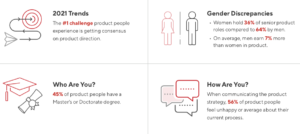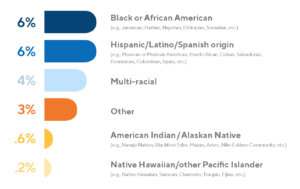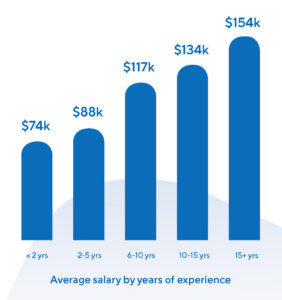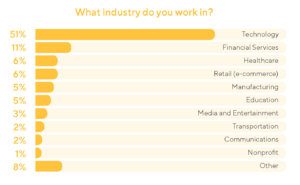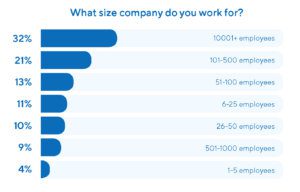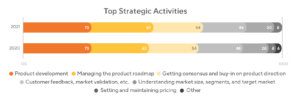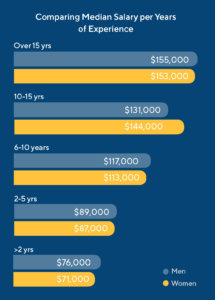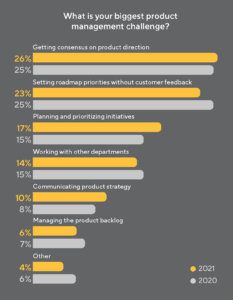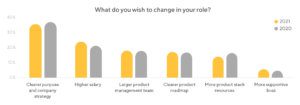Key Findings:
Short on time? Here’s what you need to know from the 2021 State of Product Management Report:
Overview of the 2021 State of Product Management Report
At ProductPlan, we sit on the front lines of helping product managers do what matters with our roadmap platform. Six years ago, we started publishing our annual product reports based on a survey of product managers worldwide. We strive to empower the product management community through data—and believe this report is one of the most important yet. Product management is a large and comprehensive industry. In this year’s report, we primarily focused on the state of salary, product strategy, challenges, gender and racial diversity, and other trends in product management.
Our 2021 State of Product Management Report is a collection of data designed to bring to life the trends driving product management. More than 2,200 product management professionals shared their insights, processes, and experiences with us. Download the entire report, here.
We hope the findings inspire meaningful conversations among the product management community and that product people have the actionable data they need to achieve their professional goals through 2021 and beyond.
Here’s our Co-founder, Jim Semick, to introduce the 2021 State of Product Management Annual Report.
Want to read this report later? Download a free copy.
Section 1
The Typical Product Manager
Key Findings:
- 60% of product people are men.
- 41% of product people are between 30-39 years of age.
- 59% of product people are White (e.g., German, Irish, English, Italian, Polish).
- 45% of product people have an advanced degree.
2021’s Diversity Breakdown
Our report polls product managers worldwide, but the majority of respondents are from the United States. The make-up of product management according to our survey is 60% men, 37% women, and 3% that either preferred not to disclose or identify as non-binary. As we dive deeper into the report, we’ll emphasize the trends we see in gender and wage inequality.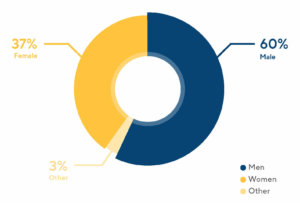
We also found that product people identify (59%) as White (e.g., German, Irish, English, Italian, Polish) or Asian (e.g., Chinese, Filipino, Asian Indian, Vietnamese, Korean, Japanese, etc.) at 22%. Unfortunately, following the top two populations, the racial representation gap grows substantially, as seen below.
Additionally, only 15% of all senior product leadership roles are held by someone who identifies as one of the following categories:
Less than 20% of all minority communities are represented in product management. Only 15% of all senior leadership is held by someone who identifies in one of these categories.
We hope that in 2021 efforts to be more diverse and inclusive continue in the workplace and hiring product teams.
Money, Money, Money
Although links between salary and motivation are often debated, at some point or another, every product person has likely asked themself if they’re being paid fairly for the value and work they bring to their team. Product managers tend to fare well in the world of compensation.
Here’s the average U.S dollar salary income of product managers based on their years of experience (excluding bonuses).
Not surprisingly, we found that bigger companies pay more. Additionally, companies in more expensive markets pay more, and more senior positions command a higher rate. In regards to a bonus, annually, 44% of product managers receive a $3,000 bonus.
Education
When it comes to a product manager’s career, there’s a looming question: to get an advanced degree or not get an advanced degree?
In our survey, across the board, 45% of product people have a Master’s or Doctorate Degree, and nearly one out of every two senior product leaders (48%) has a Master’s or Doctorate degree.

When reviewing senior product management job descriptions, you’ll see that an advanced degree is usually preferred but rarely required. It’s reported that 7% of all Harvard Business School graduates accept jobs in product management. Like an MBA, an advanced degree is highly coveted because it can equip you with a wide range of skills and expertise that the product management role entails.
An MBA isn’t an instant ticket to success. It’s a combination of formal education and real-world experience. There’s also the popular option for product managers to earn a product management certificate in addition to formal education.
Who is Hiring?
So, what does all this data mean? According to LinkedIn, interest in product management has doubled in the United States in the past 5 years. Some industries are hiring product managers more than others—especially technology (51%). The majority (32%) of product people work at a 1001+ sized company, followed by 21% at a 101-500 employee sized company.
Section 2
The Well-Being of Product Managers
Key Findings:
- 67% of product people would rather work remotely 100% of the time compared to coming into the office 100% of the time if forced to choose.
- 56% of product people are unhappy or feel average with their process for communicating their product strategy.
- 48% say their 10-year career goals are to become a product leader.
- 42% of product people view having flexible work hours as the most appealing compensation outside of salary.
- 40% say they experience imposter syndrome frequently or all the time.
Happy Product Managers, Happy Product
In a study conducted by Glassdoor, product management is the 4th best job in the United States for 2020 based on a few factors. These factors include earning potential, overall job satisfaction rating, and the number of job openings. Even during the global pandemic of 2020, we are happy to report that satisfaction is still quite high.
Product managers tend to cite the meaningful work around setting the tone for a product, understanding the customer’s pain points, leading a team, high salary, and clear career progression as reasons for their happiness. The overall happiest product people are those with more than 15 years of experience.
Product Managers and Imposter Syndrome
Imposter syndrome is a psychological term referring to a behavior pattern where people doubt their accomplishments and have a persistent, often internalized fear of being exposed as a fraud. 40% of product people say they frequently or all the time experience imposter syndrome. That means one in four of your product team members is continually doubting themselves. Additionally, product managers with 2-5 years of experience tend to feel it the most frequently (46%, all the time). Only 8% of the 2,200+ responses said that they had never felt imposter syndrome.
Tweet This:
40% of product people say they frequently or all the time experience imposter syndrome. ”
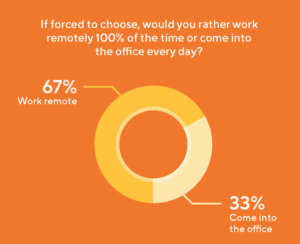 Remote Work and Benefits
Remote Work and Benefits
The experience of the global pandemic forever changed the professional world. One of the many impacts of the pandemic includes the huge jump in the desirability and willingness to work remotely and the growth of remote companies in the United States by 2.8x.
When we asked, “If forced to choose, would you rather work remotely 100% of the time or come into an office every day 100% of the time?” 67% chose to work remotely—across all company sizes. Those who especially said they prefer remote work were our respondents in older demographics. We believe that the workforce will continue this trend once the pandemic ends and possibly evolve into a hybrid model.
Part of the growing appeal of remote work is its support of flexible work hours. By allowing more flexibility in both when and where their employees work, an organization can attract and keep better people on their teams. Beyond salary, 1 in 4 product managers says the number one compensation benefit most appealing to them is flexible work hours in 2021.
Future Product Leaders
Great product leadership can be learned, and great product leadership is intentional. It’s the result of the perfect balance of collaboration, service, strategic focus, and great communication. It’s heartening to see that becoming a product leader was the number one ten-year goal of our survey. Almost half aspire to continue in product and eventually lead the products of the future.
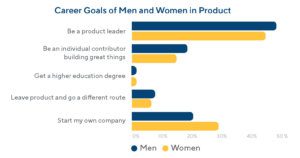
The Strategic Activities of a Product Manager
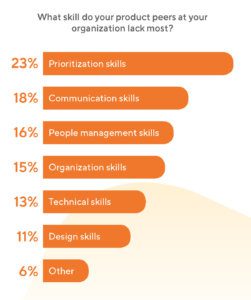
Product managers are expected to have a diverse set of skills that are considered soft and hard. Year after year, in this report, we’ve asked what the most important skill in product management is on a day-to-day basis? Communication skills always take the cake.
This year we approached the question a little differently and asked, “What skill do your product peers lack most?” While communication pulled in the second-highest amount of votes. This time, the #1 skill their peers lack is prioritization skills.
Knowing how to prioritize objectively and ruthlessly and how to respectfully turn down requests that could upset your product’s strategic priorities are extremely valuable skills.
Strategic Activities
Product managers have a unique strategic role that brings together a synthesis of exploration, analysis, and development. Not many jobs allow for this kind of professional variance or fusion. That being said, it’s all too easy to lose track of strategic direction when stand-ups, customer interviews, presentations, and many other demands crowd the calendar, vying for precious time. Year over year, most product people are spending most of their time focused on product development, managing the product roadmap, and getting consensus on product direction.
What Do Product Managers Like Least?
But even product managers who like-if-not-love those aspects of the job can have some legitimate gripes about their work environment, company culture, and coworkers. No single aspect of the job was disliked most by the majority of respondents.
Internal politics
Internal politics can be an acute pain point for product managers due to their cross-functional nature (27%). Product management must work with all these various stakeholders, and they need to get them to agree to things regularly. It puts them at the center of many political spats, power grabs, and ideological disagreements. Then, product managers often facilitate resolutions that make decisions and set the product strategy so that implementation can move forward. We also found that internal politics is especially a challenge in larger organizations.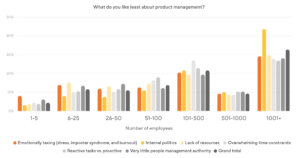
Reactive strategy
The second most common gripe from product managers dealt with reactive tasks instead of developing and executing a proactive approach (22%). Product managers report that they spend 52% of their time on unplanned fire-fighting activities.
Beyond intruding on your productivity, reactive tasks can sidetrack the entire product development organization. It might be chasing a fleeting opportunity that wasn’t part of the core vision but has suddenly, urgently presented itself. It could be custom development for a customer with little benefit for anyone else. Even addressing “emergency technical debt” can derail momentum thanks to a vendor changing an API or an app store adjusting their submission requirements.
Lack of resources
The product manager’s job involves a lot more than gathering product insight, tracking the backlog, and reviewing the product roadmap (20%). While there are many tools out there to support the work, lacking the proper resources is still a considerable challenge. Resources and tools can help product managers increase their efficiency, become better collaborators, and make sure nothing falls through the cracks. Product managers shouldn’t be shy about asking for a tools budget (product analytics, roadmap platforms, heat maps, etc). We’ll be reviewing budgets further in this report.
Communication is Everything
From the skills to the struggle, communication is at the core of it all. That’s because product managers are responsible for communicating the strategy across the team. To be happy and effective in the role, they need to communicate well and across many different formats (e.g., in person, on-screen, via email, etc.).
For the past four years, we’ve asked how happy product people are with their process for communicating their product strategy, and the results year over year aren’t good. This year, more than half (56%) say they are unhappy or simply feel average with their process for communicating the product strategy.
Section 3
Gender Diversity in Product Management
Key Findings:
- Men hold 64% of senior roles.
- 42% of men and women equally feel imposter syndrome all the time by 2-5 years of experience.
- Men, on average, earn 7% more than women.
Men vs. Women in Product Management
It’s even been proven that teams with people of different genders and races produce better results. Inclusion helps us perform better. With that in mind, the data we’ve been discussing in the 2021 State of Product Management Annual Report looks different when it’s under the lens of men’s experiences versus women’s. Men in the tech industry outnumber women, and in technical roles especially almost 2:1. This section will review how men’s and women’s careers play out in product, how their well-being is holding up, and the differences in their career goals.
“In the early to mid-2000s, Product Management at tech companies had almost the same number of men and women. The solution they came up with was to filter down to technical PMs, [with] the requirement that they have a degree in computer science — or in a related field like electrical engineering.” In 2005, women only earned about one in five CS degrees in the US, and that trend continues to this day. I believe that the new technical requirement changed the pool of potential PMs to one which was heavily male-dominated and thus unintentionally led to the industry moving away from gender-balanced teams.” – Deborah Liu, VP of Product at Facebook
Impact on Senior Leadership
The years’ impact with fewer women in product management, plus their higher churn in the role, is finding its way into senior leadership. Women hold 36% of senior product roles compared to 64% held by men.
Tweet This:
”Women hold 36% of senior product leadership roles compared to 64% held by men. ”
On top of this, churn in tech is much higher for women. According to a 2008 Harvard Business School study, 41% of women leave a decade after starting in tech, compared to 17% of men. In the graph below, after 2-5 years, there is a higher percentage of men in product management.
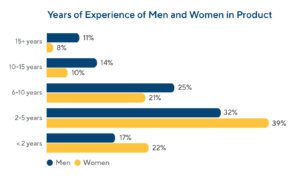 If women don’t get a strong start in product, and then leave tech at higher rates, how will we get back to gender parity again? How can we help women reach their full potential for the long-term?
If women don’t get a strong start in product, and then leave tech at higher rates, how will we get back to gender parity again? How can we help women reach their full potential for the long-term?
Salary
Overall, in product management, men make 7% more than women. Men earn a higher salary (based on years of experience) at almost every level than their female counterparts. Additionally, often having an advanced degree allows you to request a higher salary. We found men in product management are earning their Master’s and Doctorate at a higher rate than women.
Tweet This:
”Men earn a higher salary (based on years of experience) at almost every level than their women counterparts. ”
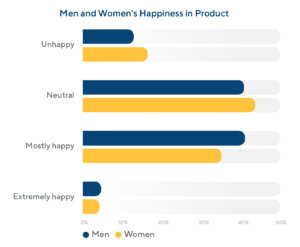
Imposter Syndrome and Happiness
Women are more likely to feel unhappy or average about their work than men, and they’re 14% more likely to frequently or always feel imposter syndrome in their careers than men. Feelings like this can have a compounding effect on a career.
Groups, like Women in Product, are actively discussing advocating for equal representation—if you’d like to support other women’s careers in product.
Section 4
Trends in 2021
Key Insights
- 64% of product teams say their primary success metrics are business and product metrics.
- 35% of product teams wish they have a clearer purpose and company strategy in 2021.
- The #1 challenge product people experience is getting consensus on product direction.
The year 2020 shifted the world in fundamental ways. It changed the way we work, learn, play, travel, and socialize. It catapulted some industries into dominance (video conferencing, food delivery) while decimating others (hospitality, tourism). In fact, 2020 brought us so many shocks and surprises that it made identifying top trends in 2021 more intriguing than ever.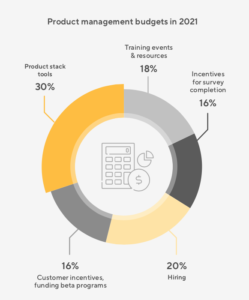
2021 Budgets
As the world invests more time and energy remotely, product managers are becoming more dependent on their product stack to keep them up-to-date, connected, and aligned with their team as they bring their products to market. Growing the product stack was voted the #1 resource product teams are allocating their budget toward in 2021. Your product stack can include product analytic tools, product roadmap software, customer survey tools, prototyping apps, and many more.
Tweet This:
“The #1 resource product teams are allocating their budget toward in 2021 is in acquiring product stack tools.”
Metrics
Any good goal is measurable. A glance at metrics can communicate if things are getting better, worse, or unchanging, far more efficiently and consistently than other, more subjective methods.
For the last two years, business-oriented metrics (33%) have been the primary product team success metric. These business-oriented metrics could include: cost to acquire a new customer, customer lifetime value, monthly recurring revenue generated by your product, the average revenue per user, conversion (e.g., the percentage who convert from free-trial users to customers).
Close behind was product metrics (31%). These are quantifiable data points that a business tracks and analyzes to gauge product strategy success—including product usage and adoption.
Challenges in Product Management
For many product managers, creating a shared strategic vision among stakeholders can be difficult, which explains why our report found that product managers’ #1 challenge is getting consensus on product direction.
Presenting the overarching strategy and rationale for key product decisions is a highly efficient way to convey this information and build consensus on product direction. Countless product strategies shifted as the pandemic took its toll on many vertical markets. It’s more important than ever to have and communicate a clear strategic vision – we expect these findings to continue in future surveys.
Tweet This:
“The #1 challenge product managers face is getting consensus on product direction. ”
Hopes for the New Year
Despite general happiness with their jobs, many product managers are still looking to make improvements in 2021. Behind the scenes, nearly 800 product professionals indicated that product strategy remains undefined or changes too frequently to serve as an anchor for prioritization and planning. The number one wish product managers hope will change in their role in the new year is to have a clearer purpose and company strategy. This need supersedes even obtaining a higher salary and a larger product management team.
Tweet This:
“The #1 thing product managers hope will change in their role in the new year is to have a clearer purpose and company strategy. ”
To succeed, product managers need a clear, well-defined vision for the product and goals to aim for. Without these in place, it’s hard to know if they’re doing the right thing. Whether it’s a North Star metric, an unwavering mission, or reliable stakeholder alignment regarding key objectives, product managers must know what they’re shooting at to have a chance at hitting it and to be able to set realistic expectations.
Conclusion
Thank you to all who participated in the 2021 State of Product Management Annual Report. We believe that empowering product managers is a critical factor in doing great work. This year’s report shows some promising trends but also revealed unsettling data trends that show inequality in the workplace. We hope next year will be quite different. There is a lot more to product management work that we didn’t get an opportunity to touch on and are excited to unpack in future reports.
At ProductPlan, we sit on the front lines of helping product managers do what matters with our roadmap platform. Six years ago, we started publishing our annual product reports based on a survey of product managers worldwide. We strive to empower the product management community through data—and believe this report is one of the most important yet.
More Insights
Report Methodology
The 2021 State of Product Management survey ran through the end of October into early November 2020. It was sent out to ProductPlan’s newsletter subscribers and shared across social media and other product management communities. We received more than 2,200 responses.
About ProductPlan
ProductPlan (productplan.com) is the most intuitive roadmap platform trusted by thousands of teams including Nike, Microsoft, and Spotify. Create collaborative roadmaps that drive strategic decisions so you can build what matters.
